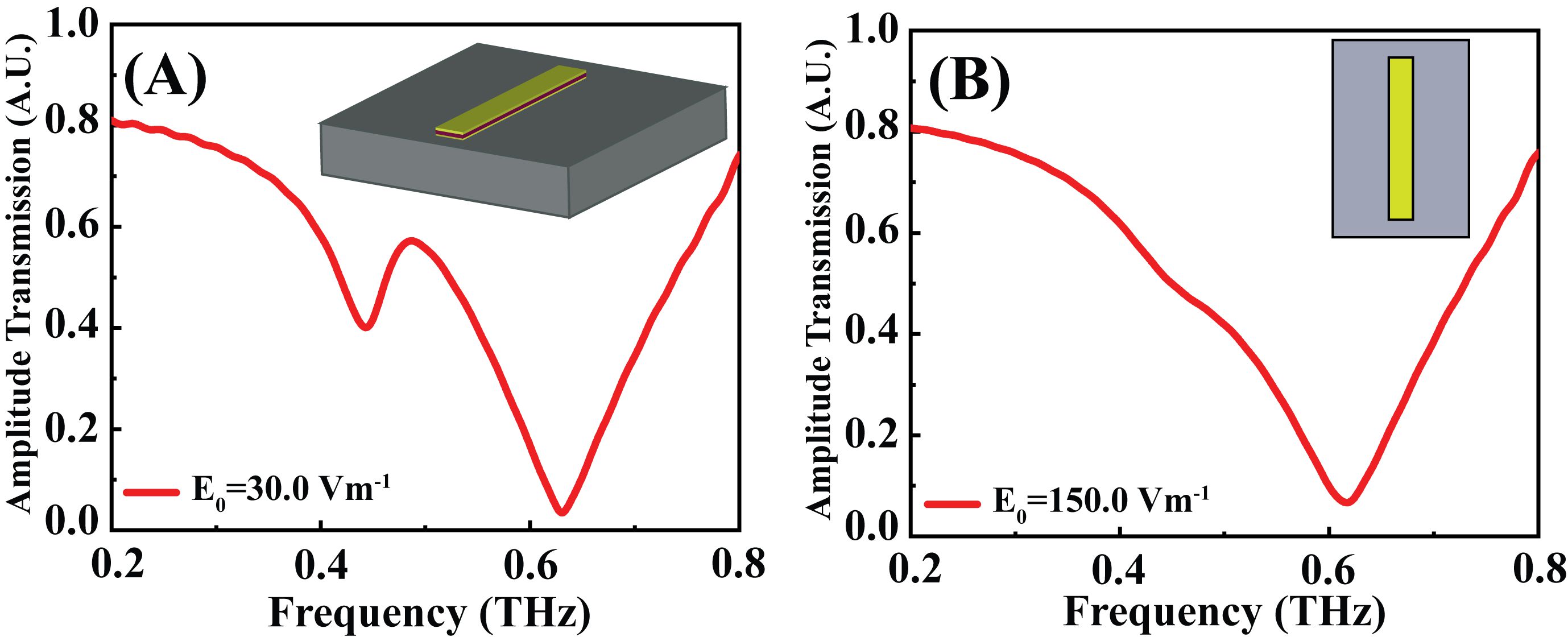Transmission Studies on Vanadium Dioxide Based Active Metasurface
Main Article Content
Article Sidebar
Abstract
We have proposed a subwavelength active metastructure in the Terahertz regime based on near-field electric (predominantly) coupling between the two resonators involved, separated by a dielectric layer. The active tuning in the metastructure was introduced by incorporating vanadium dioxide (VO2) in the spacer layer, sandwiched between the two resonating rods of aluminum metal. VO2 falls within the broad category of transition metal oxides exhibiting unusual electronic and magnetic phenomena when perturbed by external stimuli like electromagnetic fields, heat, or even mechanical strain [1, 2]. In the case of VO2, it undergoes an insulator to metal phase transition (PT) around a transition temperature of 340 K [3]. With the motivation to strongly confine electric fields in the spacer layer [4,5] in order to exploit the transitional electronic characteristics of VO2, we have explored the electromagnetic responses of our designed hybrid metastructures in this work.

Fig.1. shows the amplitude transmission for the two cases having excitation magnitudes of 30Vm-1 and 150 Vm-1 respectively. The schematic of the multilayer metasurface studied is shown in the inset of (A) while the top view of the same has been shown in the inset of (B).
The periodic metasurface was designed on top of a silicon substrate of thickness 500 μm. The two resonators were placed on top of the substrate having a thickness of 0.2 μm each, while the intermediate VO2 layer was chosen of thickness 3 μm. We have performed extensive numerical simulations to investigate the transmission responses of our metastructures in free space. The calculations were executed on commercially available finite difference time domain (FDTD) numerical solver CST Microwave Studio. The metamaterial was excited by normally incident THz radiation with the polarization of the electric vector of the incident beam parallel to the length of the resonators. We have imposed electric and magnetic boundary conditions accordingly to imitate the response of a plane wave. The incident beam energy was increased step-by-step to observe the response of the active spacer medium. The transmission amplitude of the metasurface was normalized with respect to the substrate and is shown in Fig.1(A)-(B), corresponding to the excitation signal magnitudes of 30 Vm-1 and 150 Vm-1 respectively, along with the schematics of the structures presented in the insets. For low energy irradiance as illustrated in Fig.1(A), the transmission response showed two prominent resonance dips at 0.43 THz and 0.63 THz.This is due to the inter-resonator coupling controlled by the VO2 layer in the dielectric phase. The difference in the environment of the two metallic rods in their immediate vicinity led to varied electromagnetic responses arising from the two effectively optically distinct resonators coupled through electric field lines. Thus, the splitting of the resonance dips was noted at low energy excitations alongside significantly high electric field confinement. For highly strong excitation fields at 150 Vm-1, as shown in Fig.1(B), the vanadium dioxide layer becomes conducting due to the generation of excess charge carriers followed by thermal effects, this resulted in the metallic behavior in VO2 [6]. Therefore, the two resonators collapsed effectively into one, which eventually suppressed the low-frequency resonance mode and validated the active operation of the metasurface.
In conclusion, we have presented an active VO2 based metasurface that can manipulate the electromagnetic responses by controlling the electronic state of the active VO2 layer, switching from insulator to conductor under the fulfillment of appropriate conditions. We showed that such a phase transition can be achieved through THz excitation and have further illustrated how to alter the resonance states of the metastructure. This work explores the inter-resonator coupling in metastructures and demonstrates a novel approach to optically switch the response by introducing active control in the structure. Such work has the potential to be considered as a stepping-stone in the pursuit of realizing metamaterial-based sensing, switching as well modulators [7] in the terahertz domain.
How to Cite
Article Details
[2] J. Cao et al., “Strain engineering and one-dimensional organization of metal–insulator domains in single-crystal vanadium dioxide beams,” Nature Nanotechnology, vol. 4, no. 11, Nov. 2009, doi: https://doi.org/10.1038/nnano.2009.266
[3] C. N. Berglund et al., “Electronic Properties of VO2 near the Semiconductor-Metal Transition,” Physical Review, vol 185, no. 3, Sept. 1969. doi: https://doi.org/10.1103/PhysRev.185.1022
[4] S. Karmakar et al., “Lattice-induced plasmon hybridization in metamaterials,” Optics Letters, vol. 45, no. 13, Jul. 2020, doi: https://doi.org/10.1364/OL.393702
[5] S. Karmakar, et al., “Deep‐Subwavelength Coupling‐Induced Fano Resonances in Symmetric Terahertz Metamaterials,” physica status solidi (RRL) – Rapid Research Letters, vol. 13, no. 10, Oct. 2019, doi: https://doi.org/10.1002/pssr.201900310
[6] M. Liu et al., “Terahertz-field-induced insulator-to-metal transition in vanadium dioxide metamaterial,” Nature, vol. 487, no. 7407, Jul. 2012, doi: https://doi.org/10.1038/nature11231
[7] S. Karmakar et al., “Magnetic wire: transverse magnetism in a one-dimensional plasmonic system,” Optics Letters, vol. 46, no. 6, Mar. 2021, doi: https://doi.org/10.1364/OL.414005
